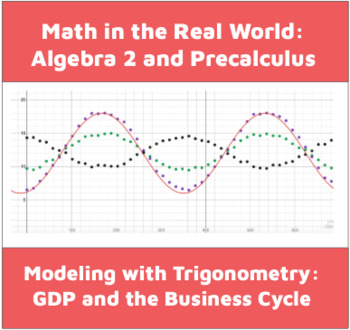Modeling the Business Cycle with Trig Functions: Activity and Data Set
- Google Docs™

Products in this Bundle (2)
Description
In this lab, students analyze GDP data from five fictional countries. To complete the activity, students:
-- create scatterplots of their data using desmos.com/calculator (or other graphing utility)
-- use their data sets to compute the parameters of underlying sinusoidal functions and use Desmos to compare their estimates to the data sets
-- interpret the parameters of their equations in context by describing how the economies of each country compare and contrast to each other.
-- are challenged to incorporate an increasing midline to model long term economic growth
-- use their graphs and equations to make investment recommendations based on the investment's time horizon
-- In the extension questions, students are introduced to the concept of spectral decomposition and learn how economists use it to model GDP data as the sum of simultaneous business cycles of different periods and amplitudes.


